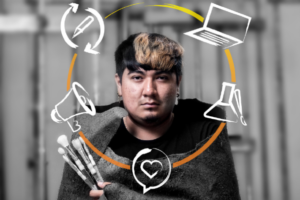What Makes a Great Creator?
How do you measure creativity?
To answer that question, Big Thought asked one of its own: What are the skills and competencies a young person needs to be able to imagine and create their best lives and world?
That query is the driving force behind the organization’s Creator Archetype™, a framework that embodies the skills that can empower youth to excel in the 21st century. To develop the Archetype, Big Thought looked to previous research and existing methods, reviewing information from organizations like the Business-Higher Education Forum and drawing inspiration from models like Battelle for Kids’ Portrait of a Graduate.
“The premise of the Creator Archetype™ isn’t new, since at its core it’s grounded in the question many educators are asking themselves: How might we prepare young people for an increasingly dynamic future?” said Alli Lee, Big Thought’s Director of Program Design. “The application of that thinking leads to identifying the skills we know are important for young people to embody and bring with them beyond traditional in-school spaces.”
While building the Creator Archetype™, Big Thought also gathered hundreds of insights from the local community, including the youth themselves. “We needed to talk to the folks working with kids right now, both in the K-12 space as well as the out-of-school time (OST) learning space,” Lee said. “But we also talked to the kids because, more often than not, they’re the last ones to get asked about what they want to learn. At Big Thought, we believe in putting youth voice first.”
 Ultimately, the intensive process led to five different domains that, together, make up the Creator Archetype™:
Ultimately, the intensive process led to five different domains that, together, make up the Creator Archetype™:
- A Social & Emotional Foundation showcases that Creators know themselves and others; they possess strong SEL skills, from self-awareness to responsible decision-making.
- A Creator’s love of lifelong learning is represented by Academics & Artistry, which focuses on the benefits of pursuits like STEAM and the performing arts.
- The demands of today’s world are reflected in Digital Fluency, which highlights how a Creator uses digital assets to express themselves and realize their ideas, whether through new technologies, data or content creation.
- Design Thinking underlines that Creators are solution-oriented and well-versed in turning ideas into action.
- Finally, Civics & Service establishes that Creators are active participants in their communities. Through volunteering, advocacy and public speaking, they work to be agents of change in all levels of government and community organizing broadly.
The Creator Archetype™ has become the foundation for Big Thought programs like the Learning Pathways Fellowship, a city-wide effort that aspires to connect skills youth develop during out-of-school experiences to the pursuit of a college degree, career certificate or entrepreneurial venture, and ultimately a livable wage. All programs offered by Big Thought will be aligned to the Creator Archetype™.
“There’s value in having this kind of structure, and in having a shared language to ask, ‘What are the things we know our young people need to have and how do we create the conditions that support them in getting there?’” Lee said.
By defining creativity and establishing criteria to measure it, OST providers can better explain the tangible benefits of their programs and how they can benefit youth.
That shared language can also help youth understand how the things they’re passionate about during their OST time can lead to future success and even future careers.
A theater program, for example, isn’t just about having an acting career. It can also be about public speaking, debate and building confidence—all skills that are applied and immensely valuable in industries like advertising, law and government. “We want to be able to open the hood for a young person and get their wheels turning about what they could do with these skills,” Lee said. “The out-of-school space feels like a home run because not only do we have youth buy-in, but adults also tend to be more bought in because these areas represent passions for them, too. That’s what makes the Creator Archetype™ a unique value to the community—the connection to out-of-school learning spaces that are not typically known for explicit skill development.
The Creator Archetype™ takes the guesswork out of the question: ‘What are the skills youth are developing out-of-school?’”
In the future, Lee also hopes the benefits can extend to the corporate world. While developing the Creator Archetype™, Big Thought worked with corporate partners to better understand the qualities they look for in employees. “We hope that young people, when sitting face-to-face with a future employer, can say, ‘I know the skills you care about show up in the Creator Archetype™. I have built and practiced those skills, which is why you should hire me.’ Relatedly, this is an immense opportunity for employers to connect with a talent pool that has been underutilized, and undervalued. Pathways, in conjunction with the Creator Archetype™, provides an opportunity for higher education and the workforce community to access a richer picture of a much wider talent pool.”
There is, of course, the chance that those highly desired skills will change as the world does. But Lee says the best approach is to continue to iterate. “We’ll continue to get input to understand the skills that fall under these domains so that we have continual community engagement.”
But no matter how Creator Archetype™ evolves, the goal is the same: to empower youth to create their best lives and world. “How might we continue to find opportunities to align the passions of the youth in our community with the experiences and skills that will position them to live a fulfilling life?” Lee said. “It’s all about finding ways to dig into that more deeply.”